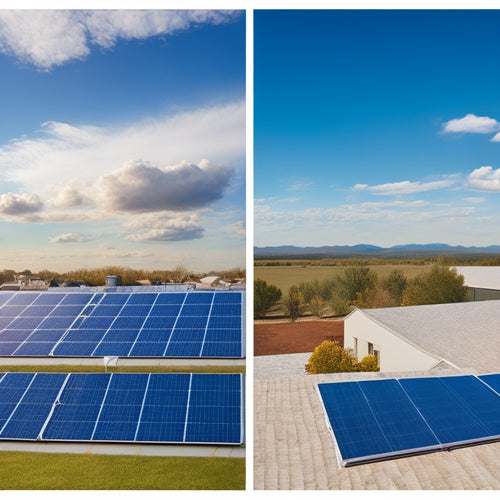
Common Misconceptions About Roof Top Solar Panel Cost: Separating Fact From Fiction
Share
You've likely heard that rooftop solar panels are too expensive, require hefty maintenance fees, and damage your roof, but these common misconceptions are preventing you from utilizing the long-term savings and benefits of solar energy. In reality, high upfront costs can be offset by financing options, long-term energy savings, and rebates. Minimal maintenance is required, and warranties cover unexpected repairs. Proper installation actually protects and extends your roof's life. Plus, government incentives like the Solar Investment Tax Credit are still available, making solar energy more accessible and affordable. As you investigate the facts, you'll realize that the benefits of rooftop solar panels far outweigh the costs.
Key Takeaways
- High upfront solar panel costs can be offset by long-term savings on energy bills, which can range from $400 to $1,000 annually.
- Financing options, such as solar loans and manufacturer financing, can make solar panels more affordable and accessible.
- Minimal maintenance is required for solar panels, which are designed to last decades, and warranties often cover unexpected repair costs.
- Proper installation of solar panels can actually extend the life of a roof, and mounting systems distribute weight evenly to prevent damage.
- Government incentives, such as the Solar Investment Tax Credit (ITC), are still available, offering a 26% tax credit on solar panel costs.
High Upfront Solar Panel Costs
Several homeowners considering rooftop solar panels are deterred by the initial investment, which can seem prohibitively expensive.
However, you shouldn't let the upfront cost discourage you from utilizing the power of solar energy. You have various financing options available to make the shift more affordable.
For instance, you can opt for a solar loan, which allows you to pay for the system in installments. Additionally, many solar panel manufacturers offer financing plans with little to no down payment. Furthermore, some states and utilities offer rebates and incentives to reduce the upfront cost.
While the initial investment may seem high, you'll reap long-term savings through reduced energy bills. In fact, according to the US Department of Energy, a typical household can save between $400 and $1,000 per year on their electricity bills by installing solar panels.
Solar Panels Are Too Expensive
Beyond the initial investment, another common misconception about rooftop solar panels is that they're too expensive to maintain and replace. However, this couldn't be further from the truth. In reality, solar panels require minimal maintenance and are designed to last for decades.
You'll be surprised to know that most solar panels come with a warranty of 25 years or more, ensuring that you're protected from any unexpected repair costs.
Moreover, many financing options are available to help you overcome the initial investment hurdle. You can opt for loans, leases, or power purchase agreements that spread the cost over time, making it more manageable.
Additionally, you'll start saving money on your electricity bills from day one, which will add up to significant long-term savings. In fact, according to the U.S. Department of Energy, homeowners who install solar panels can save up to $500 per year on their electricity bills.
With the right financing options and long-term savings, the cost of solar panels becomes a worthwhile investment for your home and the environment.
Hidden Maintenance Fees Exist
You've likely heard claims that rooftop solar panels come with hidden maintenance fees that can add up quickly. However, this is largely a myth. The truth is that solar panels require very little regular maintenance.
In fact, they're designed to last for 25 years or more with minimal upkeep. Most manufacturers recommend cleaning the panels every six months to a year, which can be done with a simple hose down. This task is often so easy that many homeowners choose to do it themselves, eliminating any maintenance fees altogether.
In the rare event of unexpected repairs, most reputable solar panel companies will provide warranties that cover parts and labor for a certain number of years. This means you won't be stuck with surprise bills or hidden fees.
Additionally, many companies offer maintenance plans that can be rolled into your initial purchase, providing you with peace of mind and protection from unexpected expenses.
With proper installation and routine cleaning, your solar panels will continue to generate clean energy for years to come, without breaking the bank.
Solar Panels Damage Roofs
Your roof is a significant investment, and the thought of solar panels damaging it can be unsettling. However, with proper installation, solar panels are designed to protect and even extend the life of your roof.
The installation process typically involves a thorough inspection of your roof to identify any potential issues before the panels are installed. This guarantees that any necessary repairs are made beforehand, preventing further damage.
Here are some reasons why solar panels won't damage your roof:
- Solar panels are attached to your roof using a mounting system that's designed to distribute the weight evenly, preventing pressure points that could cause damage.
- The installation process is typically non-invasive, meaning that no holes or penetrations are made in your roof, reducing the risk of leaks or water damage.
- Solar panels can actually increase roof longevity by protecting the surface from weathering and UV rays, which can cause degradation over time.
Government Incentives Are Gone
Misconceptions about government incentives for solar panels can be a considerable deterrent for homeowners considering a rooftop installation.
You may think that government incentives have disappeared, making solar panels unaffordable. However, this is far from the truth. While it's true that some incentives have expired, others remain in place or have been replaced with new ones.
For instance, the Solar Investment Tax Credit (ITC) allows you to claim a tax credit of 26% of the total cost of your solar panel system. This can greatly reduce your upfront costs.
In addition, many states and utilities offer their own incentives, such as rebates or performance-based incentives. Moreover, financing options are available to help you spread the cost of your solar panel system over time.
These options can make going solar more accessible and affordable. Don't let misconceptions about government incentives hold you back from considering rooftop solar.
With the right financing options and incentives, you can start generating clean energy and saving money on your energy bills.
Frequently Asked Questions
Can I Install Solar Panels on a Shaded Roof?
You can install solar panels on a shaded roof, but it'll affect solar panel efficiency. Consider shaded roof solutions like optimized panel placement, tree trimming, or specialized panels designed to maximize energy production in low-light conditions.
How Long Does a Typical Solar Panel Installation Take?
You're wondering how long a typical solar panel installation takes. The installation timeline varies depending on installation factors like roof size, complexity, and local permits, but on average, you can expect a residential installation to take around 3-5 days.
Do Solar Panels Work During Power Outages?
You invest in solar panels for energy independence, but do they work during power outages? Unfortunately, no, they don't, as they're grid-tied for safety and solar panel efficiency; however, you can consider battery backup systems for uninterrupted power supply during outages.
Can I Sell My Excess Solar Energy Back to the Grid?
You can sell your excess solar energy back to the grid through net metering, earning solar energy credits that offset your utility bills; this process allows you to generate revenue and reduce your carbon footprint.
Are Solar Panels Resistant to Hail and Extreme Weather?
As you shield your home from the storm, your solar panels stand strong, symbolizing resilience. You'll find that most panels are designed to withstand hail damage and boast impressive weather durability, ensuring your investment remains secure in the face of extreme weather conditions.
Conclusion
You've made it to the end of our myth-busting expedition, and it's clear that rooftop solar panel costs aren't as intimidating as they seem. In reality, the average American family saves around $500 per year on their electricity bill with solar panels. What's more, the International Energy Agency estimates that solar power could become the largest source of electricity globally by mid-century, with costs dropping by 70% over the past decade. It's time to shine a light on the facts and make an informed decision about going solar.
Related Posts
-

Charging Points in Rural Areas: 5 Key Insights
When driving through rural areas, you'll face a shortage of charging points, making EV ownership stressful and inconv...
-

10 Best Ways to Purify Urban Air With EVS
You're looking for ways to purify urban air with Electric Vehicles (EVs). You can start by incorporating EVS Air Filt...
-

Tracking Solar Panels Vs Fixed Panels Cost Savings
When considering solar panel options, you'll want to weigh the cost savings of tracking solar panels versus fixed pan...


